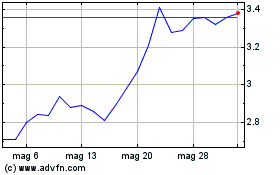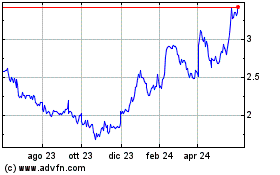Arbutus Biopharma Corporation (Nasdaq: ABUS) (“Arbutus” or the
“Company”), a clinical-stage biopharmaceutical company leveraging
its extensive virology expertise to develop a functional cure for
people with chronic hepatitis B virus (cHBV) infection, today
announced new data from its Phase 2a clinical trial IM-PROVE I
(AB-729-201) showing that imdusiran, the Company’s RNAi
therapeutic, and 24 weeks of pegylated interferon alfa-2α (IFN), a
standard-of-care immunomodulator, added to ongoing nucleos(t)ide
analogue (NA) therapy, reduced HBsAg levels and led to sustained
HBsAg loss in some patients with cHBV during and after treatment.
These data were presented today in the Viral Hepatitis B and D: New
therapies, unapproved therapies or strategies poster session, and
will be featured during a poster tour on Thursday, June 6, 2024, at
the European Association for the Study of the Liver (EASL)
Congress.
Select key data from this Phase 2a clinical
trial include:
- Some patients who received either
48 or 24 weeks of imdusiran and 24 weeks of IFN with their ongoing
NA therapy achieved undetectable HBsAg at the end-of-treatment
(EOT) (33.3%, n=4/12; and 23.1%, n=3/13, respectively) that was
sustained 24 weeks after completing imdusiran and IFN treatment
(33.3%, n=4/12 and 15.4%, n=2/13, respectively). All six patients
with sustained HBsAg loss have seroconverted with high anti-HBsAg
antibody levels (43.8 to >1,000 mIU/mL suggestive of immune
control) and are being followed for maintenance of both
undetectable levels of HBsAg and HBV DNA for 24 weeks while off all
therapy to assess for a functional cure.
- Two of the six patients have
reached 12 weeks off all therapy while maintaining both
undetectable levels of HBsAg and HBV DNA. The remaining four
patients are at various timepoints less than 12 weeks off therapy
with undetectable levels of HBsAg and HBV DNA.
- A total of 21 patients from across
the four treatment cohorts have discontinued all therapy and are in
the follow-up period. One patient that received 12 weeks of IFN
treatment with imdusiran and NA therapy has maintained undetectable
levels of HBsAg and HBV DNA while off all therapy for six months,
thereby achieving a functional cure.
“These data are impressive with robust HBsAg
response rates that are sustained after end-of-treatment in
patients receiving imdusiran and IFN,” commented Professor Man-Fung
Yuen, D.Sc., M.D., Ph.D., Chief of the Division of Gastroenterology
and Hepatology, the University of Hong Kong, who presented the data
at the Congress. “Unlike other RNAi candidates in development that
have been evaluated in combination with IFN, in this trial,
imdusiran was administered less frequently, at a lower dose, and
when combined with a shorter 24-week course of IFN, achieved
undetectable HBsAg that is sustained after end of treatment and
into early off-treatment follow-up. This trial evaluated small
groups of patients, yet there is reason to believe that the
combination of imdusiran and IFN could potentially lead to a
functional cure in those patients that remain off all therapy.
These data are extremely important for the HBV community, and I
look forward to continuing to follow the patients who have
discontinued all treatment.”
To confirm undetectable HBsAg measured by the
trial assay (lower limit of quantitation of 0.05 IU/mL), the Abbott
HBsAg Next Qualitative assay, an ultrasensitive, research use only
assay with a detection limit of 0.005 IU/mL, was utilized.
The Next Assay confirmed HBsAg loss in six of the seven patients at
EOT, and those six maintained HBsAg loss for 24 weeks after
completing imdusiran and IFN treatment.
These data from the IM-PROVE I trial suggest
that the combination of imdusiran and 24 weeks of IFN was generally
safe and well-tolerated. There were no serious adverse events
(SAEs) related to imdusiran or IFN, and no adverse events (AEs)
leading to discontinuation. The most common imdusiran-related
treatment emergent adverse events (TEAEs) were transient ALT
elevations and injection site bruising. The IFN-related TEAEs were
consistent with the known safety profile of IFN.
“There is a significant need for a functional
cure for the more than 250 million patients chronically infected
with HBV worldwide,” commented Dr. Karen Sims, Chief Medical
Officer of Arbutus Biopharma. “These data further support our
belief that lowering surface antigen with imdusiran and
incorporating an immunomodulator in the treatment regimen has the
potential to provide a functional cure for patients with cHBV. We
look forward to following the progress of these patients as well as
those in our other Phase 2a trials evaluating imdusiran with other
immunomodulators.”
The poster that was presented at EASL Congress
2024 can be accessed through the Arbutus website under
Publications.
IM-PROVE I Trial Details
The IM-PROVE I Phase 2a clinical trial
(AB-729-201; NCT04980482) enrolled 43 HBeAg-negative, NA-suppressed
patients with cHBV infection. After a 24-week lead-in with
imdusiran (60 mg every 8 weeks) added to ongoing NA therapy,
patients were randomized into one of the following four
cohorts:
A1: Imdusiran + NA + IFN weekly for
24 weeks (n=12)
A2: NA + IFN weekly for 24 weeks
(n=13)
B1: Imdusiran + NA + IFN weekly for
12 weeks (n=8)
B2: NA + IFN weekly for 12 weeks
(n=10)
After completion of the IFN treatment period
(Week 52 for cohorts A1 and A2 and Week 40 for cohorts B1 and B2),
patients underwent a 24-week follow-up period on NA therapy alone
and were then assessed for discontinuation of NA therapy. Patients
with ALT levels less than two times the upper limit of normal,
undetectable HBV DNA, and HBsAg <100 IU/mL at two consecutive
visits at least 24 weeks after the last dose of imdusiran,
qualified to discontinue all therapy and will be followed for at
least 48 weeks. Safety, antiviral and immunologic assessments were
obtained throughout the treatment and follow-up periods. HBsAg was
assessed via Roche Cobas Elecsys HBsAg II assay (lower limit of
quantitation [LLOQ] = 0.05 IU/mL) and results <LLOQ were
analyzed by Abbott HBsAg Next Qualitative assay (detection limit =
0.005 IU/mL).
About Imdusiran (AB-729)
Imdusiran is an RNA interference (RNAi)
therapeutic specifically designed to reduce all HBV viral proteins
and antigens including hepatitis B surface antigen, which is
thought to be a key prerequisite to enable reawakening of a
patient’s immune system to respond to the virus. Imdusiran targets
hepatocytes using Arbutus’ novel covalently conjugated
N-Acetylgalactosamine (GalNAc) delivery technology enabling
subcutaneous delivery. Clinical data generated thus far has shown
single and multiple doses of imdusiran to be generally safe and
well-tolerated, while also providing meaningful reductions in
hepatitis B surface antigen and hepatitis B DNA. Imdusiran is
currently in multiple Phase 2a clinical trials.
About HBV
Hepatitis B is a potentially life-threatening
liver infection caused by the hepatitis B virus (HBV). HBV can
cause chronic infection which leads to a higher risk of death from
cirrhosis and liver cancer. Chronic HBV infection represents a
significant unmet medical need. The World Health Organization
estimates that over 250 million people worldwide suffer from
chronic HBV infection, while other estimates indicate that
approximately 2.4 million people in the United States suffer from
chronic HBV infection. Approximately 820,000 people die every year
from complications related to chronic HBV infection despite the
availability of effective vaccines and current treatment
options.
About Arbutus
Arbutus Biopharma Corporation (Nasdaq: ABUS) is
a clinical-stage biopharmaceutical company leveraging its extensive
virology expertise to identify and develop novel therapeutics with
distinct mechanisms of action, which can be combined to provide a
functional cure for patients with chronic hepatitis B virus (cHBV).
We believe the key to success in developing a functional cure
involves suppressing HBV DNA, reducing surface antigen, and
boosting HBV-specific immune responses. Our pipeline of internally
developed, proprietary compounds includes an RNAi therapeutic,
imdusiran (AB-729), and an oral PD-L1 inhibitor, AB-101. Imdusiran
has generated meaningful clinical data demonstrating an impact on
both surface antigen reduction and reawakening of the HBV-specific
immune response. Imdusiran is currently in three Phase 2a
combination clinical trials. AB-101 is currently being evaluated in
a Phase 1a/1b clinical trial. For more information, visit
www.arbutusbio.com.
Forward-Looking Statements and
Information
This press release contains forward-looking
statements within the meaning of the Section 27A of the Securities
Act of 1933 and Section 21E of the Securities Exchange Act of 1934,
and forward-looking information within the meaning of Canadian
securities laws (collectively, forward-looking statements).
Forward-looking statements in this press release include statements
about the potential to lead to a functional cure for HBV, our
future development plans for our product candidates; the expected
results of our clinical development plans and clinical trials with
respect to our product candidates; our expectations with respect to
the release of data from our clinical trials and the expected
timing thereof; and the potential for our product candidates to
achieve success in clinical trials.
With respect to the forward-looking statements
contained in this press release, Arbutus has made numerous
assumptions regarding, among other things: the effectiveness and
timeliness of preclinical studies and clinical trials, and the
usefulness of the data; the timeliness of regulatory approvals; the
continued demand for Arbutus’ assets; and the stability of economic
and market conditions. While Arbutus considers these assumptions to
be reasonable, these assumptions are inherently subject to
significant business, economic, competitive, market and social
uncertainties and contingencies.
Additionally, there are known and unknown risk
factors which could cause Arbutus’ actual results, performance or
achievements to be materially different from any future results,
performance or achievements expressed or implied by the
forward-looking statements contained herein. Known risk factors
include, among others: anticipated pre-clinical studies and
clinical trials may be more costly or take longer to complete than
anticipated, and may never be initiated or completed, or may not
generate results that warrant future development of the tested
product candidate; Arbutus may elect to change its strategy
regarding its product candidates and clinical development
activities; Arbutus may not receive the necessary regulatory
approvals for the clinical development of Arbutus’ products;
economic and market conditions may worsen; market shifts may
require a change in strategic focus.
A more complete discussion of the risks and
uncertainties facing Arbutus appears in Arbutus’ Annual Report on
Form 10-K, Arbutus’ Quarterly Reports on Form 10-Q and Arbutus’
continuous and periodic disclosure filings, which are available at
www.sedar.com and at www.sec.gov. All forward-looking statements
herein are qualified in their entirety by this cautionary
statement, and Arbutus disclaims any obligation to revise or update
any such forward-looking statements or to publicly announce the
result of any revisions to any of the forward-looking statements
contained herein to reflect future results, events or developments,
except as required by law.
Contact Information
Investors and Media
Lisa M. Caperelli Vice President, Investor
Relations Phone: 215-206-1822 Email:
lcaperelli@arbutusbio.com
Grafico Azioni Arbutus Biopharma (NASDAQ:ABUS)
Storico
Da Dic 2024 a Gen 2025

Grafico Azioni Arbutus Biopharma (NASDAQ:ABUS)
Storico
Da Gen 2024 a Gen 2025
